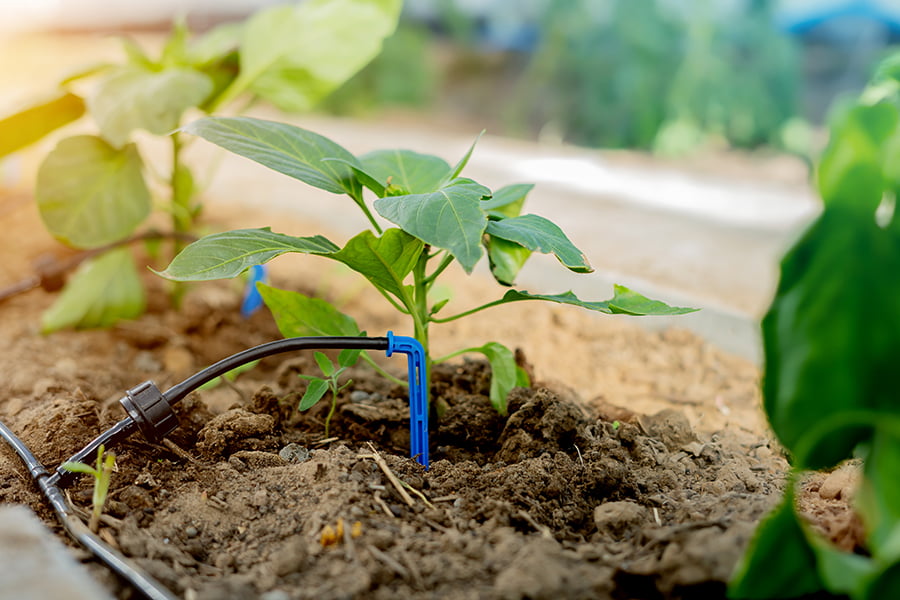Preparing soil for xeriscaping involves tilling the soil to a depth of 8-12 inches, removing rocks and debris, adding organic matter such as compost or manure, and testing the pH level.
Xeriscaping is an increasingly popular landscaping technique that uses drought-tolerant plants to reduce water consumption. Preparing your soil for xeriscaping is essential for ensuring the success of your project.
In this blog, we’ll discuss some of the steps you can take to prepare your soil for xeriscaping and create a beautiful, low-maintenance landscape.
Look Inside:
Testing Soil PH

Soil pH is a measure of how acidic or alkaline the soil is, and it affects the availability of nutrients to plants. A pH level between 6.0 and 7.5 is ideal for most plants, so testing your soil’s pH can help you determine if any amendments are needed before planting.
To test your soil’s pH, you will need a simple home test kit that can be purchased at most garden centers or online stores. The kit typically includes a small bottle with liquid reagents and instructions on how to use them to measure the acidity of your soil sample.
After collecting a sample from several different areas in your yard, mix it with water according to the instructions provided in the kit and then add some drops of reagent solution into each sample container until it changes color. Compare this color change against the chart included in the kit to determine what range your soil falls into on the pH scale (acidic, neutral or alkaline).
If necessary, you can adjust its acidity by adding lime or sulfur depending on whether you want to make it more acidic or more alkaline respectively.
Adding Organic Matter

Organic matter helps improve the structure of the soil, making it more porous and allowing water to penetrate deeper into the ground. It also increases the amount of nutrients available to plants, which can help them thrive in a dry climate.
Adding organic matter can be done by mixing compost or aged manure into the top few inches of soil before planting. This will help create a healthy environment for plants and reduce their need for supplemental irrigation.
Amending Soil With Sand or Gravel

This process involves adding either sand or gravel to the existing soil in order to improve its drainage and aeration capabilities. The addition of these materials helps create a better environment for plants, as it allows water and air to move more freely through the soil.
Sand and gravel also help increase the amount of organic matter present in the soil, which can provide essential nutrients for plant growth. When amending your soil with sand or gravel, it is important to use a coarse material that will not compact easily when wet.
You should ensure that you are using enough material so that it covers at least one-third of your total garden area before planting any plants.
Choosing Drought-tolerant Plants

Drought-tolerant plants are those that can survive in dry conditions and require minimal water to thrive. When selecting these types of plants, it is important to consider the climate and soil type in your area as well as the amount of sunlight available.
You should research which species are native to your region so that they will be better adapted to local conditions. Once you have chosen the right drought-tolerant plants for your landscape, you can then prepare the soil by adding organic matter such as compost or mulch and adjusting its pH level if necessary.
This will help ensure that your xeriscape thrives with minimal water use while still providing a beautiful outdoor space.
Installing a Drip Irrigation System

Drip irrigation systems are designed to deliver water directly to the roots of plants, minimizing evaporation and runoff. This helps conserve water while still providing adequate moisture for plant growth.
The system consists of a network of pipes, emitters, and valves that are connected to a water source such as a hose or faucet. To install the system, you will need to dig trenches around each planting area and lay down the pipes in them.
You will then need to connect the emitters at regular intervals along the pipe so that they can deliver water directly into the root zone of each plant. You will need to attach valves at various points along the pipe so that you can control how much water is delivered where it’s needed most.
Installing a drip irrigation system is an effective way to ensure your soil has enough moisture for xeriscaping without wasting any extra resources.
Applying Mulch to Conserve Moisture

Applying mulch involves spreading a layer of organic material over the topsoil. This layer acts as a barrier between the soil and the air, preventing water from evaporating too quickly.
It also helps to keep weeds at bay and can add nutrients to the soil over time. When applying mulch, it’s important to use an organic material such as wood chips or bark that will break down slowly and provide long-term benefits for your plants.
Spread a 2-3 inch layer of mulch evenly across your garden beds, taking care not to pile it up against tree trunks or other plants where it could cause rot or disease.
